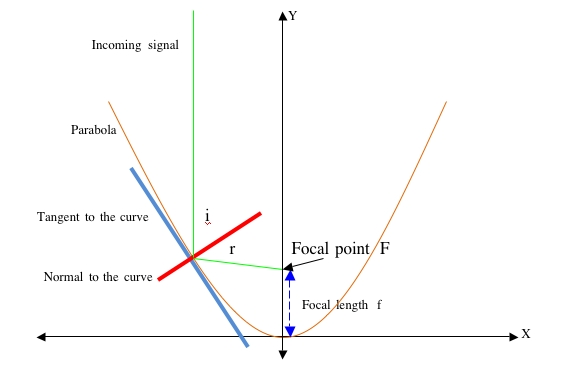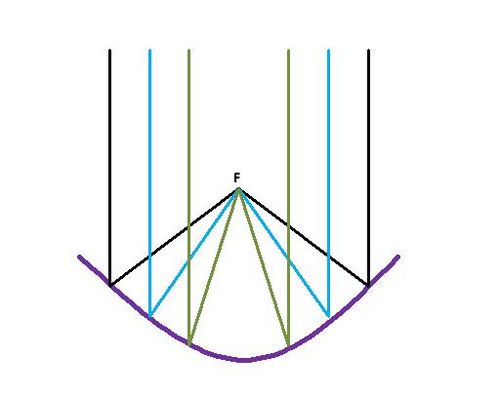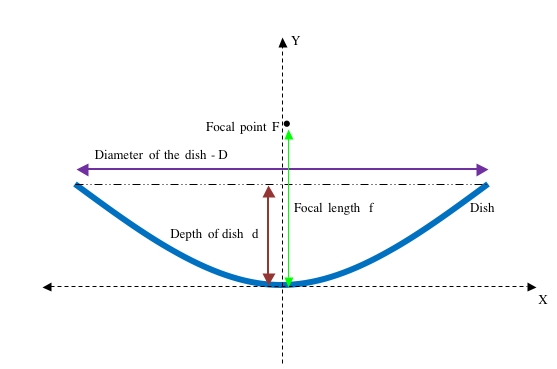Dish or Parabola: Difference between revisions
(added off-set dish diagram) |
No edit summary |
||
| Line 30: | Line 30: | ||
<math> f = \frac {D^2}{16d} </math> where '''D''' is the diameter of the dish and '''d''' is the depth of the dish | <math> f = \frac {D^2}{16d} </math> where '''D''' is the diameter of the dish and '''d''' is the depth of the dish | ||
==Gain of a dish antenna== | == Offset-fed dish antenna == | ||
[[Image:Vk4yeh_off_centre_dish.JPG |500px]] | |||
== Gain of a dish antenna == | |||
Related wiki page - [[Gain]] | Related wiki page - [[Gain]] | ||
| Line 47: | Line 51: | ||
For practical purposes, the most critical measurement affecting the gain (regardless of dish size) of a dish antenna has been found to be placing the feedpoint exactly at the focal length '''f'''. Paul Wade - [http://www.qsl.net/n1bwt/preface.htm W1GHZ], gives the following relative gain measurements for a 22inch dish with <math> \frac{f}{D} =0.39 </math> operating at 10GHz: | For practical purposes, the most critical measurement affecting the gain (regardless of dish size) of a dish antenna has been found to be placing the feedpoint exactly at the focal length '''f'''. Paul Wade - [http://www.qsl.net/n1bwt/preface.htm W1GHZ], gives the following relative gain measurements for a 22inch dish with <math> \frac{f}{D} =0.39 </math> operating at 10GHz: | ||
{| style="width:55" border = "1" | {| style="width:55" border = "1" | ||
| Feed distance || Relative gain | | Feed distance || Relative gain | ||
| Line 60: | Line 63: | ||
|---- | |---- | ||
|----|} | |----|} | ||
Revision as of 17:22, 6 August 2008
A number of sources have been used to gain information for this page - including the excellent online microwave antenna book by Peter Wade [http:www.qsl.net/n1bwt/preface.htm W1GHZ]. The diagrams are original.
Parabolic Geometry
A Parabola is one of the “conic sections” and is defined as the locus (path) of a point that travels so that it is equidistant from a fixed point and a straight line. Algebraically this can be reduced to:
<math> y = ax^2</math> where a is a constant
More specifically, <math> y = \frac{x^2}{4f} </math> where f is the focal length – distance from the curve to the focal point
In the diagram above:
- the Y axis is central to the curve
- the tangent is a line that touches the curve at one point and has the same gradient as the curve at that point
- the normal is perpendicular to the tangent at the point of contact with the curve
- i is the angle of incidence – the angle between the incoming signal and the normal
- r is the angle of reflection – the angle between the reflected signal and the normal
- i = r Angle of incidence = Angle of reflection
- a broad beam entering the parabola will be reflected to and concentrated at the focal point
During receive, the signal is concentrated at the focal point F. During transmit, a feed point at F will produce a beam of RF energy.
Finding the focal length of a parabolic dish
<math> f = \frac {D^2}{16d} </math> where D is the diameter of the dish and d is the depth of the dish
Offset-fed dish antenna
File:Vk4yeh off centre dish.JPG
Gain of a dish antenna
Related wiki page - Gain
the gain of a dish antenna (compared to an isotropic standard) can be calculated thus:
<math> Gdbi = 10\times \mbox{log} \left( \eta \frac {4 \pi}{\lambda^2}A \right) </math> where:
<math> \eta </math> is the efficiency of the dish
<math> A </math> is the area of the dish
<math> \lambda </math> is the wavelength of the signal
The efficiency is perhaps the most difficult variable to maximise - generally 50% is considered to be reasonable, but 70% - 80% can be achieved with very good feeds.
For practical purposes, the most critical measurement affecting the gain (regardless of dish size) of a dish antenna has been found to be placing the feedpoint exactly at the focal length f. Paul Wade - W1GHZ, gives the following relative gain measurements for a 22inch dish with <math> \frac{f}{D} =0.39 </math> operating at 10GHz:
| Feed distance | Relative gain |
| 8.125" | -0.6dB |
| 8.250" | 0dB |
| 8.375" | -0.3dB |
| 8.625" | -1.7dB |


